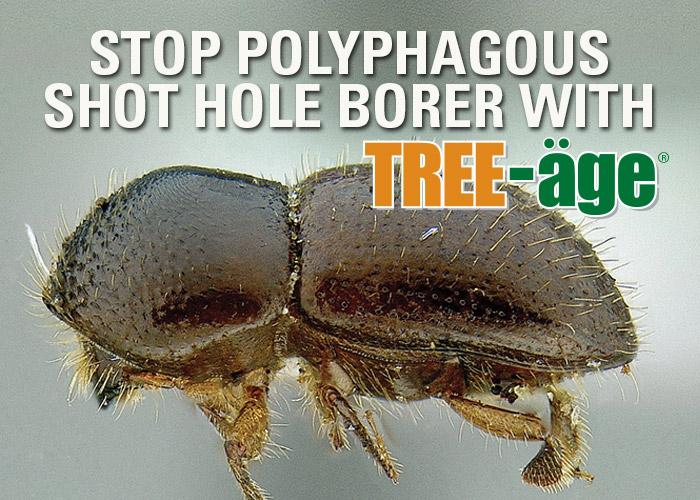Polyphagous shot hole borer (PSHB) is an exotic ambrosia beetle that was first detected in 2003 in Southern California and only recently was found to be killing several species of trees. The “ambrosia” name refers to a symbiotic fungus that is carried by the female in special organs in her mouth parts. The fungus is grown in the beetle galleries and both the adult beetles and larvae feed on the fungi.
Trees at Risk: Attack & Infection
This beetle attacks a large number of plant species, mostly hardwoods, but can only reproduce in 31 species including maples, sycamore, oaks, willows, alders, and avocado. The characteristics of PSHB attack and fungus infection differ among tree species. The beetle produces a very precise, perfectly round, tiny entry hole, less than 0.1 inch in diameter in most trees.
Early symptoms of beetle attack include wet staining and discoloration on the bark of the main stem and branches. Depending on the tree species attacked, PSHB injury can be identified either by staining, gumming, or a sugaring response on the outer bark. Infection with the fungus can cause leaf discoloration and wilting, dieback of entire branches, and tree mortality.
Treat PSHB with TREE-äge®
Uninfested and lightly-infested host trees that are in known areas of infestation can be treated with TREE-äge® insecticide. Preventative treatment with TREE-äge® prior to or just after initial PSHB attack is the better management option. If a tree is showing light to moderate attack levels, treatment with TREE-äge plus a compatible fungicide is recommended. Treatments can be made any time of year when there is good soil moisture to encourage uniform distribution throughout the tree. Trunk injections with insecticide will distribute upward in the tree within 4-6 weeks with adequate soil moisture.
Prepare Ideal Conditions with NutriRoot
Generally, the best seasons for injection are spring and fall, since uptake occurs when trees are transpiring. The environmental conditions that favor uptake are adequate soil moisture and relatively high humidity. Hot weather and/or dry soil conditions may slow translocation of product into foliage so water trees before and after treatment application. The addition of a soil surfactant, such as NutriRoot, as a drench or sub-surface soil injection will encourage water to move deeper into the soil and increase moisture availability to the tree over time. If treating trees in the summer, inject in the morning for the quickest uptake.
Do you have questions about, PSHB, TREE-äge® or NutriRoot? Contact us!
©2015 Arborjet, Inc. Important: Always read and follow label instructions. Some crop protection products may not be registered for sale or use in all states or counties. Please check with your state or local extension service to ensure registration status. TREE-äge® Insecticide is a Restricted Use Pesticide and must only be sold to and used by a state certified applicator or by persons under their direct supervision. TREE-äge® is a registered trademark of Arborjet, Inc.

